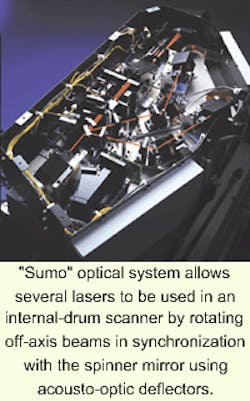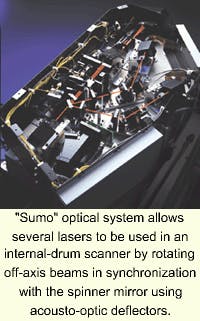GRAPHIC ARTS: DRUPA showcases new printing technologies
Ron Gibbs
Over the past 20 years, lasers have made an enormous impact on the printing industry because they have been at the heart of various digital-image-output technologies used to make printing plates. The recent DRUPA trade exhibition in Düsseldorf, Germany (May 18-31, 2000) provided a unique opportunity to assess the current trends in laser applications within commercial printing.
Last held in 1995, DRUPA is the major international showcase event for the printing industry, with nearly 2000 companies exhibiting in 18 halls, presenting their current and future products to more than 400,000 visitors from around the world. This year, more lasers than ever were in evidence, featuring prominently in many of the products on exhibit.
Platesetting
Printing plates for offset lithographythe dominant printing process for most high-quality print applications (brochures, magazines, and newspapers, for example)work by having surface properties in half-tone image areas that are different from those in nonimage areas. Image areas attract the oil-based ink, while nonimage areas repel it. Conventionally, the plates are imaged by ultraviolet (UV) contact exposure of thin photoresist layers by large transparency films that are produced on laser imagesetters. In the computer-to-plate (CTP) process, the plate is imaged directly by laser scanning in a platesetter. Because UV lasers are expensive and impractical in printers' environments, various plate chemistries have been developed to take advantage of the properties of other lasers.
When CTP systems first appeared 10 years ago, the only low-cost, reliable lasers were low-power, 488-nm argon-ion and red-emitting HeNe lasers.
As new and better semiconductor and all-solid-state devices emerged, the plate manufacturers developed new chemistries.
In imagesetters, low-power red-emitting laser diodes have almost completely replaced HeNe and argon-ion lasers. As the image size and speed of these systems increases, the pressure for multiple beam systems grows to overcome modulation bandwidth limits. At DRUPA, Fujifilm Electronic Imaging (Hemel Hempstead, England) showed its novel Sumo optical system, which enables several lasers to be used in an internal-drum scanner by rotating off-axis beams in synchronization with the spinner mirror using acousto-optic deflectors (see Fig. 1).
Thermal CTP
The most popular CTP systems use thermal plates that react to laser-induced temperature changes. These require relatively high-power lasers (tens of watts, continuous-wave). Plates fall into two fundamental classes, using either ablation of a thin layer or thermally induced cross-linking of a polymer layer.
Diode-pumped Nd:YAG lasers can produce more than 15 W at 1064 nm and are widely used in CTP systems. Being single-mode, they are particularly suited to internal-drum scan configurations. Purup-Eskophot (Lystrup, Denmark) showed a new system using a fiber laser amplifier with more than 16-W power. This type of laser, originally developed by Polaroid, has the potential to deliver even higher single-mode power.
The most commercially successful systems, however, are based on 830-nm laser diodes. Creo/Scitex (Burnaby, BC, Canada) has established market leadership with its Trendsetter products, which use a 40-W laser-diode bar. The multimode output from the line of 19 coupled laser facets is imaged through a 256-channel light valve in a multiple-beam external-drum configuration.
The other 830-nm device commonly used is the 1-W single-facet diode, with up to 96 fiber-coupled lasers arranged in an array. In a low-cost variation, Presstek (Hudson, NH) has developed a monolithic array of four independent 0.75-W diodes that use 16 devices per system (see Fig. 2).
These external-drum, 830-nm print heads lend themselves naturally to on-press plate imagingone of the newest and fastest-growing print technologies. Both Creo and Presstek (also a plate manufacturer) have established themselves as leaders in this market by alliances with press manufacturers.
Two companies independently introduced new systems that use a diode bar in a single-beam scanning configuration (acousto-optic Scophony scanning), in which the traveling wave in a Bragg cell is matched to the scanning speed, thus enabling a line source to be imaged at a single spot. Gretag Imaging (Richmond, BC, Canada) uses this technique in an internal drum, while Barco Graphics (Gent, Belgium) uses it in a flatbed scanner with up to six optically butted f/theta scanning subsystems to produce a long scan line.
Visible-light CTP
Thermal plates do not yet meet all offset printers' needs. In particular, newspapers require faster imaging speeds, which are currently met by more-sensitive visible photopolymer plates. These are exposed by 532-nm frequency-doubled diode-pumped Nd:YAG (FDY) lasers with typical output power of 100 mW. Because of their relative complexity and use of exotic crystals, these lasers are much more expensive than laser diodes, whose cost has come down dramatically as manufacturing volume and yield have increased. It was noticeable at DRUPA that argon-ion lasers have now been largely superseded in this application.
Many new systems featured violet-blue 405-nm diode lasers. At this wavelength, very sensitive silver-based plates can be exposed at very high speed with only 5 mW or less and handled under bright yellow safelight (competing systems use more expensive 15-mW FDY lasers with dark-red safelight, requiring external modulation). These lasers are expected to become very low-cost and reliable because of their use in mass-market DVD players.
According to Thomas Weber of TuiOptics (Munich, Germany), which supplies packaged diode modules, the lifetime of Nichia diodes is expected to improve to 5000 hours by the end of the year, which would make them viable for this application. Weber expects diode prices to eventually drop from the current $2000 to less than $100. Several suppliers predicted that the eventual availability of 30-mW devices would enable the use of photopolymer plates, with simpler, cheaper, and more environmentally friendly processing.
The state of competition between different CTP processes is illustrated by the approach of Purup-Eskophot, which has designed its latest system to allow field conversion of the laser source between any of four different wavelengths in less than one hour. The jury is still out on which system will become the industry standard.
Flexography
For printing on packaging materials such as cardboard and plastic, flexography (flexo), based on surface-relief plates, is rapidly taking over from offset. According to DuPont (Wilmington, DE), one of the two dominant suppliers of direct flexo plates, the use of laser platesetters has dramatically improved both the quality and productivity of platemaking, leading directly to the rapid growth in flexo printing. For this application high-power lasers are required to ablate a resist layer.
Creo showed a new flexo platesetter system based on a 60-W laser bar. Leading supplier Barco Graphics is supplementing its 60-W lamp-pumped Nd:YAG laser-based platesetters with a new 15-W diode-pumped Nd:YAG system. The improved laser-mode quality improves optics efficiency and increases the depth of focus for better productivity and plate quality. Hell Gravure Systems (Kiel, Germany) also combined high power with single-mode beam quality in its new system based on an array of eight fiber-amplifier 1064-nm lasers of 8 W each.
Ron Gibbs is an independent consultant specializing in the design of laser and optical scanning systems at Gibbs Associates, Dunstable LU6 2PT, England; e-mail: [email protected]. He is a member of the Laser Focus World editorial advisory board.

